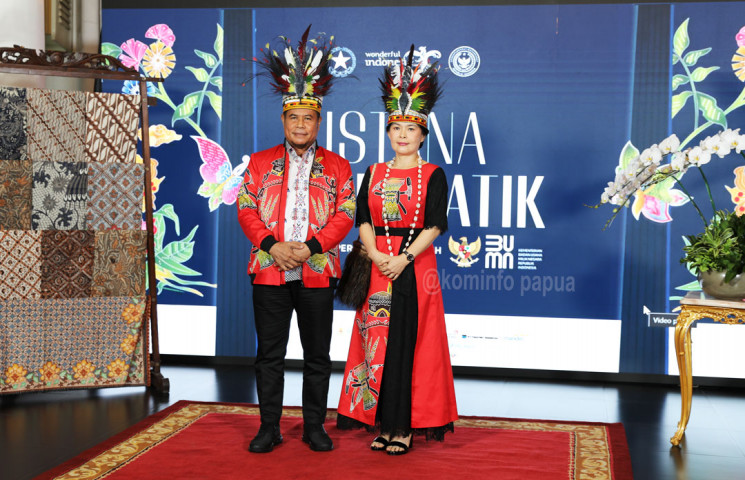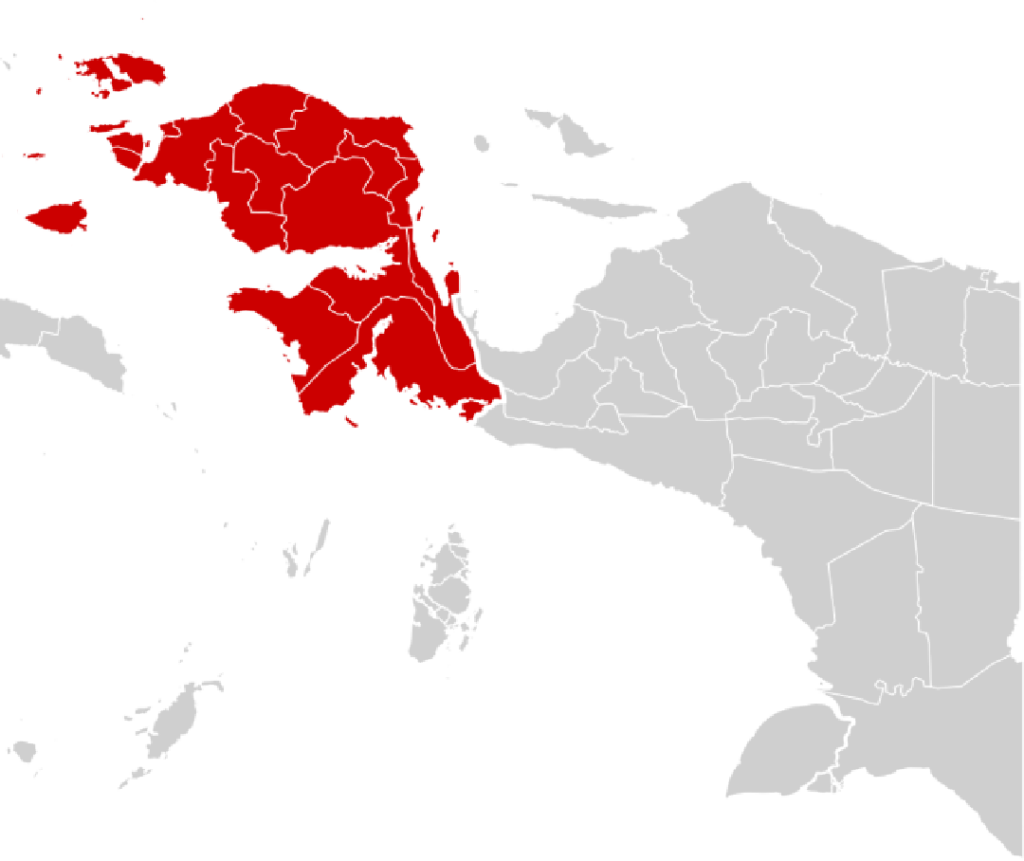The morning sun rose gently over Jayapura Bay on October 2, 2025, casting a golden shimmer across the rooftops of government buildings where hundreds of civil servants gathered to commemorate National Batik Day. But on this particular morning, the air felt different. Instead of the standard uniforms that usually fill official ceremonies, the crowd was a sea of color and pattern — the rich reds, yellows, and blues of Papua Batik, each design telling its own story of land, people, and spirit.
Across Papua’s regencies, from Jayapura to Nabire, the same celebration unfolded. Offices, schools, and public institutions asked their employees to wear batik — not the familiar Javanese parang or megamendung motifs, but textiles emblazoned with the cenderawasih, the sago palm, and the tifa drum — the symbols that breathe life into the culture of Papua.
For the people of Papua, this was not merely a ceremonial day on the national calendar. It was a reaffirmation of identity, a moment to assert that Papua has its own batik, one born of the island’s forests, rivers, and ancestral stories.
A Living Heritage
According to Cenderawasih Pos, the provincial government of Papua marked the national celebration with a commitment to strengthen and preserve local batik traditions. Jeri Agus Yudianto, Head of the Provincial Office of Communication and Informatics, said that wearing batik on National Batik Day was more than symbolic — it was a declaration of continuity. “We want this culture to remain alive and bring economic benefit to the Papuan people,” he said.
The government has long recognized that Papua Batik, like its more established counterparts from Java or Madura, carries both artistic and economic promise. Each fabric represents hours of meticulous work — the wax-resist technique, the hand-painting of motifs, the slow rhythm of dyeing and drying. Yet beyond the craft lies something deeper: a connection between heritage and livelihood.
In recent years, Papua’s leaders have actively encouraged artisans, designers, and youth communities to develop local batik industries. They believe that by preserving these traditions, Papua can turn culture into capital — transforming art into a viable form of creative economy.
The Soul of Papua in Motifs
The uniqueness of Papua Batik lies in its imagery. Instead of the geometric precision or royal symbolism found in Central Java’s classic batik, Papua’s patterns are bold, organic, and alive with natural forms.
The most iconic is the bird-of-paradise motif, representing beauty and spiritual grace. Its sweeping feathers and motion embody the essence of Papua — vibrant, proud, and free. Alongside it, the sago tree often appears, symbolizing sustenance and unity, as sago has long been a staple in Papuan daily life. The canoe, too, is a recurring symbol — representing journey and connection across the rivers that link coastal and inland communities.
Other designs portray the honai, a traditional round hut from the highlands, and the tifa, a drum used in ceremonies and dances. Some even feature abstracted shapes inspired by animal totems, forest leaves, or tribal carvings. Every motif is a visual story, a bridge between generations.
For many Papuans, wearing batik adorned with these symbols is a way to wear their identity — to literally carry their stories on their skin. In this way, Papua Batik is not merely fashion; it is language, history, and belonging.
Roots and Rebirth
Historically, batik was not native to Papua. The art form, originating in Java centuries ago, reached Papua through cultural exchange and migration. Yet the people of Papua quickly made it their own. Over the last two decades, as artisans in cities like Jayapura, Biak, and Merauke began experimenting with wax and dye, the first generations of Papuan batik-makers emerged.
Through workshops supported by the local government and cultural foundations, these artisans learned the techniques — but they infused them with Papuan imagery, creating something entirely new. This hybrid craft soon found its identity: modern batik with the heart of Papua.
Unlike traditional Javanese batik, which often adheres to rigid rules and centuries-old patterns, Papuan batik is fluid, contemporary, and expressive. It mirrors the diversity of the island’s 250 tribes and countless dialects. Each region brings its own interpretation: coastal batik often uses bright marine tones, while highland artisans prefer earthy reds and browns derived from natural dyes.
This process of localization — taking a national art form and reshaping it to reflect local life — is what makes Papua Batik distinct. It is both Indonesian and Papuan, both inherited and reinvented.
Government Commitment to Cultural Economy
The Provincial Government of Papua has been increasingly vocal in turning cultural preservation into economic empowerment. In statements to Papua News Online, provincial officials emphasized that both batik and noken (the traditional woven bag recognized by UNESCO as intangible cultural heritage) are central to Papua’s creative economy strategy.
The government envisions batik and noken as dual symbols of pride — tangible expressions of heritage that also generate income for local artisans, especially women in rural communities. To this end, several initiatives have been launched: regular batik fairs in Jayapura, training programs for young designers, and even export cooperation talks with small business associations in other provinces.
Some government offices have gone further by formalizing batik usage. Civil servants are now encouraged — and in some districts, required — to wear Papuan batik at least once a week. The idea is simple but powerful: to make cultural pride visible in everyday life, not confined to annual ceremonies.
This institutional support has had ripple effects. Schools and local cooperatives have begun organizing workshops, while tourism agencies promote batik as a must-have souvenir for visitors. Step by step, the threads of culture and commerce are being woven together.
Bridging Tradition and Innovation
Papua’s young designers are at the forefront of this transformation. Many see batik not as something old-fashioned, but as a platform for creativity. Fashion shows in Jayapura, including the Papua Street Carnival, have featured collections that combine traditional motifs with modern cuts — jackets, sneakers, and accessories that appeal to younger audiences.
The results are striking. On social media, Papuan batik is gaining visibility under hashtags like #BatikPapua and #PrideofPapua. Influencers and local artists wear it in videos and performances, giving the tradition a modern resonance.
In interviews, designers often describe their mission as twofold: to protect the heritage of their ancestors and to project it forward into new spaces — global markets, fashion runways, and cultural festivals.
The synergy between heritage and innovation is exactly what cultural economists describe as the key to sustainable creative industries. By blending authenticity with adaptability, Papua’s batik artisans are ensuring that their craft will endure beyond nostalgia — it will evolve with time.
Challenges Along the Way
Despite the growing momentum, challenges remain. Many batik workshops in Papua are small-scale, operating with limited resources. Access to quality materials — fabrics, dyes, and tools — can be difficult in remote areas. Transport costs raise prices, making it harder for local batik to compete in national markets.
Another concern is intellectual property protection. Because Papuan motifs are unique, there is a real risk of exploitation — that larger companies might reproduce these designs without credit or compensation. Several regional governments, including Papua Barat, have begun pushing for copyright protections and geographical indications for their motifs, but enforcement remains limited.
Then there is the challenge of awareness. Outside Papua, few Indonesians are familiar with Papuan batik. National media coverage tends to focus on Java, leaving eastern Indonesia underrepresented. To truly flourish, Papua Batik needs storytelling — in tourism, education, and digital platforms — that introduces its symbols and meanings to the broader public.
Finally, generational continuity poses a risk. Without sustained engagement from youth, traditional art forms often fade. That is why local governments and NGOs are investing in education: teaching batik-making in vocational schools, offering entrepreneurship training, and providing access to markets through online platforms.
From Local Heritage to Global Identity
Papua’s ambition is not only to preserve its batik for local pride but to project it onto the global stage. Officials have expressed hopes that Papuan Batik could follow the trajectory of Java’s batik — becoming a recognized cultural export. Already, some designers have participated in exhibitions in Jakarta and Bali, with plans to bring Papuan collections to regional craft fairs in Australia and the Pacific.
The potential is vast. Tourists visiting Papua can now find batik products at Sentani Airport and local handicraft markets. Each piece comes with a tag explaining the motif’s meaning — a subtle but powerful act of cultural education. When travelers take these textiles home, they carry a fragment of Papua’s story with them.
In time, this could form the backbone of a sustainable creative economy — one where artisans earn dignified incomes, youth find inspiration in tradition, and culture itself becomes a driver of prosperity.
Weaving the Future
As the flag ceremony in Jayapura concluded on that bright October morning, the civil servants dispersed, their colorful shirts glimmering under the sunlight. Some stopped for photos, others chatted about the meaning of the motifs they wore. Behind their smiles lay a quiet sense of pride — not just for the art on their backs, but for what it represented: unity in diversity, continuity amid change.
Papua Batik is more than fabric. It is a reminder that culture lives not in museums but in the daily choices of people — in what they wear, make, and value. It tells of a region that, though distant from Indonesia’s political center, stands firmly within the nation’s cultural heart.
If the momentum continues — with strong government support, creative innovation, and community ownership — Papua Batik could become both a national treasure and an international symbol of identity and resilience.
And so, each National Batik Day is more than a celebration of cloth. It is a celebration of spirit — the enduring artistry of a people who, through wax and dye, continue to paint their place in Indonesia’s living tapestry.
Conclusion
The commemoration of National Batik Day in Papua reflects more than a symbolic gesture — it represents a movement to protect and promote Papua Batik as both a cultural identity and an economic opportunity. Through strong government support, creative collaboration, and youth innovation, Papua is transforming batik from a traditional art into a living industry that empowers local artisans and strengthens regional pride.
Despite ongoing challenges such as limited market access, intellectual property protection, and infrastructure gaps, the growing enthusiasm across communities shows that Papua Batik has become a unifying emblem of creativity and resilience. Each motif — from the bird-of-paradise to the sago tree — weaves together the story of Papua’s people, landscape, and spirit.
If nurtured consistently, Papua Batik will not only preserve a proud heritage but also project Papua’s identity onto the national and global stage — proving that culture, when sustained with purpose, can become the fabric of both memory and progress.


